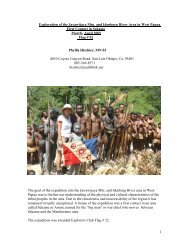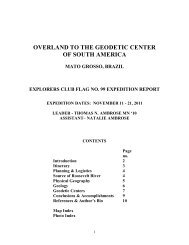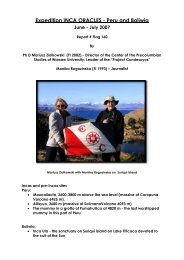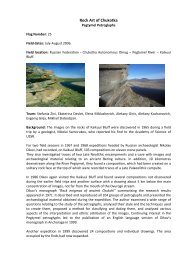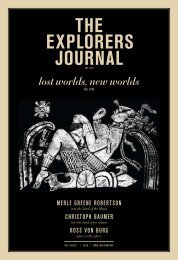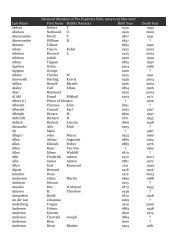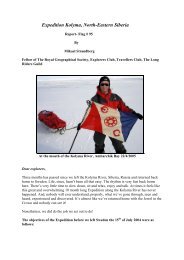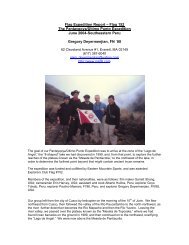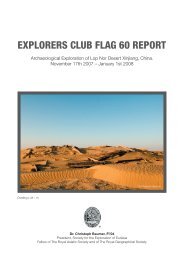the explorers journal the global adventure issue - The Explorers Club
the explorers journal the global adventure issue - The Explorers Club
the explorers journal the global adventure issue - The Explorers Club
- No tags were found...
You also want an ePaper? Increase the reach of your titles
YUMPU automatically turns print PDFs into web optimized ePapers that Google loves.
of nor<strong>the</strong>rn Canada, and <strong>the</strong>illusory terrors of a malevolentsupernatural creature of <strong>the</strong>ice, it is something human thatproves to be <strong>the</strong> most terrifyingthing of all.60Wild Places:Wild Heartsby Allen Smutylo302 pp • Owen Sound, Ontario: TomThomson Art Gallery, 2007 • ISBN:978-0-929021-47-8 • $60Award-winning Canadian artistand author Allen Smutylo’sWild Places: Wild Hearts:Nomads of <strong>the</strong> Himalaya isboth an artist’s memoir andan anthropologist’s journey.After decades spent withnomadic peoples in <strong>the</strong> HighArctic, Patagonia, and <strong>the</strong>Amazon, Smutylo decided togo to <strong>the</strong> Himalaya. While ineastern Ladakh in 2001, heencountered <strong>the</strong> Changpa,a widely dispersed group ofTibetan nomads. Eventually,Smutylo joined <strong>the</strong> Kharnakpatribe—one of four groups hetraveled with—on migrationas <strong>the</strong>y crossed an isolatedplateau of rock, sand, and ice4,500 meters above sea level,on yaks and horses. On thisjourney he met <strong>the</strong> chomos,nuns whose lives are spenton remote mountainsides inREVIEWSstone huts, wea<strong>the</strong>ring bitterwinters, waiting for <strong>the</strong>occasional visit of <strong>the</strong> clanon migration. He writes thatas he moved between <strong>the</strong>world of <strong>the</strong> Changpa and <strong>the</strong>modern world, he began tounderstand that far from beinga relic, <strong>the</strong> Changpa hadmuch to teach us. “In contrastto <strong>the</strong> tenets of our society,I saw compatibility with <strong>the</strong>environment, inclusiveness inspirituality, and an emphasison non-material things.”T h e H i g h R o a d t oChina: George Bogle,<strong>The</strong> pachen Lama, and<strong>the</strong> first BritishExpedition to Tibetby Kate Teltscher336 pp • New York: farrar, straus,A nd Girou x , 20 07 • ISBN -10 : 0 3742170 0 9ISBN-13: 978-0374217006 • $26Kate Tektscher, authorof <strong>the</strong> acclaimed IndiaInscribed, begins her latestbook, High Road to China:George Bogle, <strong>the</strong> PanchenLama, and <strong>the</strong> First BritishExpedition to Tibet, with afascinating account of <strong>the</strong>1780 meeting between <strong>the</strong>Third Panchen Lama of Tibetand <strong>the</strong> Chinese EmperorQianlong in Chengde, <strong>the</strong>“two most exalted figureson Earth.” That it took <strong>the</strong>Panchen Lama a year to travelfrom Lhasa to Chengde to celebrate<strong>the</strong> emperor’s seventiethbirthday immediately sets<strong>the</strong> stage. During <strong>the</strong> celebrations,<strong>the</strong> Lama asked <strong>the</strong>emperor to entertain relationswith <strong>the</strong> English governor ofIndia (Hindostan), WarrenHastings. Teltscher examines<strong>the</strong> purpose of this strangeencounter and <strong>the</strong> reasonsfor <strong>the</strong> Tibetan spiritualleader would have wanted tohelp <strong>the</strong> English achieve <strong>the</strong>irlong desired entry into China.Despite <strong>the</strong> warm personalrelationship that developedbetween <strong>the</strong> English representative,Scotsman GeorgeBogle—who had been sentto Tibet on behalf of <strong>the</strong>British East India Companyin 1774 to begin trade negotiations—and<strong>the</strong> PanchenLama, diplomatic realtionsbetween England, Tibet, andChina were fraught, resultingin <strong>the</strong> Opium Wars of1839–42 and 1885–60. Inhis diaries, Bogle revealsa genuine curiosity andrespect for <strong>the</strong> Lama and<strong>the</strong> Tibetans. Unfortunately,his successor, FrancisYounghusband, would massacre500 Tibetans on hisdiplomatic mission of 1904.Teltscher’s account of thisearly diplomatic foray and itsaftermath reverberates todayin <strong>the</strong> ever-changing politicallandscape of <strong>the</strong> Himalaya.



